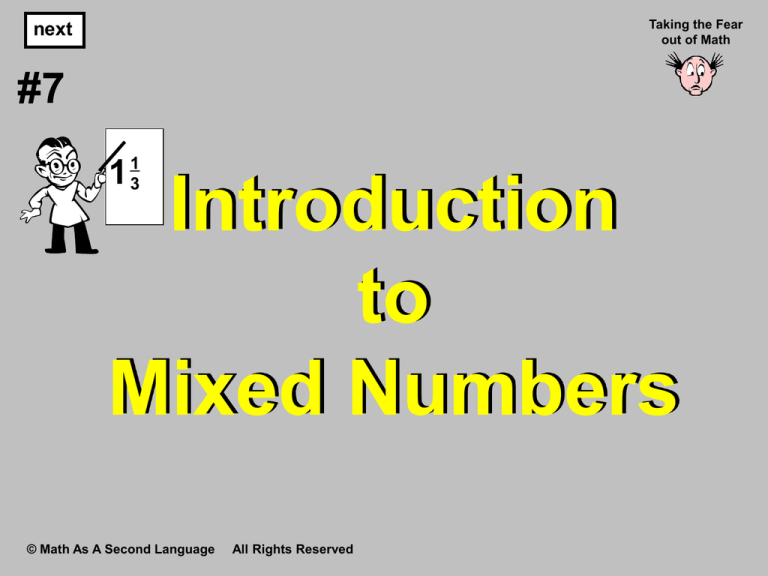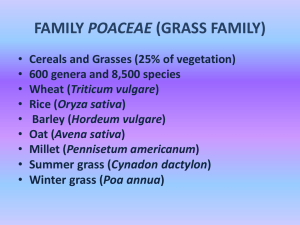
Taking the Fear
out of Math
next
#7
1
1
3
Introduction
to
Mixed Numbers
© Math As A Second Language
All Rights Reserved
next
The best way to comprehend a new
topic is by discovering that it is simply
a different form of what you already know.
This idea extends to how we can introduce
mixed numbers to our students in a natural
(and relevant) way in terms of our
“adjective/noun” theme.
For example, long before students
become aware of such numerals as
5 7/12 they have probably come into
contact with such expressions as a
person being 5 feet 7 inches tall.
© Math As A Second Language
All Rights Reserved
next
Notes
In this context, we have “mixed together”
two nouns (feet and inches) and modified
each with a whole number adjective.
If we wish to express this height using only
one noun, we can either express it in inches
or in feet. If we elect to use inches, we use
the fact that since there are 12 inches in a
foot, there are 60 inches in 5 feet.
Thus, in 5 feet 7 inches there are 67 inches.
© Math As A Second Language
All Rights Reserved
next
Notes
If we prefer to use feet as the noun, we have
5 “whole” feet plus 7 of the 12 inches that
are needed for an additional foot.
Expressed as a fraction
“7 of what it takes 12 of to make 1 foot”
is 7/12 feet.
Therefore, we may express 5 feet 7 inches
in the form (5 + 7/12) feet.
© Math As A Second Language
All Rights Reserved
next
Notes
We agree to omit the plus sign and
abbreviate 5 + 7/12 by writing 5 7/12 .
While 5 7/12 ≠ 67, 5 7/12 feet = 67 inches .
Although it is correct to write 5 feet 7 inches
as 4 feet 19 inches, and therefore write
5 7/12 feet as 419/12 feet; the convention is
1
that
we
do
not
do
that.
note
1 1This corresponds with the idea of getting good estimates. For example, we
could say that the height of a person was 3 feet 37 inches. However, it gives
us a better idea of the height, if we say 6 feet 1 inch. In a similar way, if we
are packing books into cartons that hold 12 books each we don't usually say
that we have 3 full cartons and 37 books left over. Namely, we keep packing
cartons until there aren’t enough books left to fill another carton.
© Math As A Second Language
All Rights Reserved
next
Notes
Specifically, we define a mixed number as
being the sum of a whole number plus a
rational number that is less than 1.2
The definition of a mixed number can be
motivated by our earlier discussion of
dividing 2 corn breads equally among
3 people.
note
2 When we use a common fraction to represent rational numbers, we call the
common fraction a proper fraction if it represents a rational number that is
less than 1. In this context, the mathematical definition of a mixed number is
that it is the sum of a whole number and a proper fraction.
© Math As A Second Language
All Rights Reserved
next
Because there aren’t enough
corn breads to give each person
a whole corn bread, we slice each of
the 2 corn breads into 3 equally sized
pieces and give each person 1 piece
from each corn bread.
1 piece
Corn
1 piece
Bread
1 piece
1 piece
Corn
1 piece
Bread
1 piece
© Math As A Second Language
All Rights Reserved
next
Now suppose that instead of 2 corn breads
and 3 people there were 3 corn breads and
2 people.
If we did what we did previously, to divide
the 3 corn breads equally between the
2 people, we could slice each corn bread
in half (i.e., into 2 pieces of equal size) and
give each person 1 piece from each of the
3 corn breads.
© Math As A Second Language
All Rights Reserved
next
If we denote the two people by A and B, the
result can be viewed as pictured below…
B
A
© Math As A Second Language
A
Corn Bread
B
A
Corn Bread
B
A
Corn Bread
B
All Rights Reserved
next
In this way, we see that each person
got 3 of what it takes 2 of to equal
a whole corn bread.
This evolves into the language of
fractions in the following way…
3 corn breads ÷ 2 persons =
6 pieces of corn bread ÷ 2 persons =
3 pieces of corn bread per person =
3 halves of a corn bread per person =
3/
2
© Math As A Second Language
corn bread per person.
All Rights Reserved
next
And if we omit the nouns we see that
3 ÷ 2 = 3/2.
However, since there are more corn breads
than people we can give each person at
least one whole corn bread without having
to slice it into 2 equally sized pieces.
Since 3 ÷ 2 = 1 R1, we can give each
person 1 corn bread, and we can then slice
the third cornbread into 2 pieces of equal
size and give each person one of the 2
pieces.
© Math As A Second Language
All Rights Reserved
next
Pictorially…
A
A
11/2 corn breads
A
B
11/2 corn breads
B
B
© Math As A Second Language
All Rights Reserved
next
In this way, each person gets 1 whole
corn bread and half of another corn bread;
that is, 1 corn bread + 1/2 of a corn bread.
In other words, another way to write the
answer is…
3 corn breads ÷ 2 persons =
(1 corn bread + 1/2 of a corn bread) per person =
(1 + 1/2) corn breads per person =
To write the answer in a more compact way
we omit the plus sign and write…
3 ÷ 2 = 11/2
© Math As A Second Language
All Rights Reserved
next
In summary, the rational number
that’s defined by the quotient 3 ÷ 2 can
be represented by many different
numerals; among which are 3/2 and 11/2.3
In the case of 3 corn breads and 2 people,
it didn’t really make much difference whether
we first sliced each of the corn breads into
2 equally sized pieces or whether we waited
until there was only 1 corn bread left before
we divided a corn bread into 2 pieces of
equal size.
note
3 In a later presentation, we will introduce decimals and in the language of
decimals we can represent 3 ÷ 2 by 1.5.
© Math As A Second Language
All Rights Reserved
However, as the number of people and/or
the number of corn breads increases in
size, slicing each corn bread into a number
of equally-sized pieces becomes more and
more cumbersome.
For example, suppose 200 corn breads are
to be shared equally by 3 people.
next
It would be extremely tedious to slice each
corn bread into 3 equally-sized pieces, and
even if the corn breads had already been
sliced this way, it would still be very tedious
to “deal” the pieces of corn bread, one
at a time, to the 3 people.
© Math As A Second Language
All Rights Reserved
next
Most likely, we would revert to our
knowledge of whole number division and
compute that 200 ÷ 3 = 66 “with 2 left
over”.
Therefore, if we wanted to use the least
amount of effort to distribute the corn
breads, we would give each person 66 corn
breads, and we would then divide the
remaining 2 corn breads among the
3 people by giving each person 2/3 of a corn
bread. Thus, altogether each person
receives 66 2/3 corn breads.
© Math As A Second Language
All Rights Reserved
next
Notes
While it might be quite cumbersome,
there is nothing wrong with having each
of the 200 corn breads sliced into
3 pieces of equal size and then give
each person 1 of the 3 pieces from each
of the 200 corn breads.
© Math As A Second Language
All Rights Reserved
next
Notes
In other words…
200 corn breads ÷ 3 persons =
600 pieces of corn bread ÷ 3 persons =
200 pieces of corn bread ÷ 1 person =
200 pieces of corn bread per person =
200 of what it takes 3 of to equal
1 corn bread per person =
200/ corn breads per person.
3
© Math As A Second Language
All Rights Reserved
next
Notes
We often refer to 200/3 as an improper fraction.
Generally, the common fraction n/m is
called an improper fraction if n ≥ m. The
reason is that an improper fraction can
always be expressed as the sum of a
whole number and a proper fraction.
© Math As A Second Language
All Rights Reserved
next
Notes
However there is nothing that is really
“improper” about an improper fraction.
For example, if a recipe calls for 21/3 cups of
flour and you can only find your “1/3 of a cup”
measuring cup, all you have to remember is
that every time you fill this cup 3 times, it is
equivalent to 1 whole cup.4
note
4 In fact, for a person who might have “fraction anxiety”, you never have to refer to
it as 1/3 of a cup. Instead all you have to tell the person is that if you fill this
3 times it is equal in measure to 1 whole cup.
That way, the person never hears the word “fraction”.
© Math As A Second Language
All Rights Reserved
next
Notes
If you fill it 6 times, you have 2 whole cups
and then 1 more time will give you 21/3 cups.
However, just as in pre-slicing corn breads,
there is nothing wrong with saying that you
used 7 thirds of a cup; that is, 7 of what it
takes 3 of to equal 1 whole cup. 5
note
5`The nice thing about the adjective/noun theme is that it affords us a wide range of
choices as to how to visualize the connections between mixed numbers and
improper fractions. For example, one way to visualize, why 45/6 is equivalent
to 29/6 is to think of cartons that hold 6 books each. If there are 6 books per
carton and we want to express the total number of books that are contained in
45/6 cartons, we multiply 4 by 6 to obtain the number of books in the 4 full
cartons and then add the books that are in the 5th carton.
In this context, each book is 1/6 of a carton, and there are 29 of them.
© Math As A Second Language
All Rights Reserved
next
Improper Fractions to
Mixed Numbers
There are times when we wish to
express the quotient of two whole
numbers as an improper fraction and
other times when we want to express
the quotient as a mixed number.
The examples we used in this
discussion give us a nice segue
for seeing how to convert from
one form to the other.
© Math As A Second Language
All Rights Reserved
next
For example, to convert the improper
fraction 74/9 into a mixed number, we may
think of dividing 74 corn breads equally
among 9 people. Since 74 = 8 × 9 “with
2 left over”, we may give each person
8 whole corn breads, then divide each of
the remaining 2 corn breads into 9 pieces
of equal size, and then give each of the
9 persons 1 piece from each of the
2 remaining corn breads.
In this way, we see that each person gets
82/9 corn breads.
© Math As A Second Language
All Rights Reserved
next
In terms of a rote formula, we divide
74 by 9 in the “usual” way to obtain…
8 R2
9 74
72
2
…and we then write the remainder
over the divisor to obtain 82/9.
© Math As A Second Language
All Rights Reserved
next
Mixed Numbers to
Improper Fractions
Conversely, if we had wanted to convert
82/9 into an equivalent improper fraction, we
could have visualized 82/9 as modifying
corn breads. So if each corn bread was
presliced into 9 pieces of equal size (thus
ensuring that “1 ninth” meant
“1 piece”), we would see that we had a
total of (8 × 9) + 2 or 74 pieces.
© Math As A Second Language
All Rights Reserved
next
In other words…
82/9 corn breads =
74 pieces of corn bread =
74 ninths of corn bread =
74/
9
© Math As A Second Language
corn bread
All Rights Reserved
next
Again, from a purely mechanical point
of view it is the same as if we had multiplied
the whole number (8) by the denominator of
the proper fraction (9) to obtain 72, after
which we add the numerator of the proper
fraction (2) to obtain 74, and finally we write
this over the denominator of the proper
fraction to obtain the answer (74/9).
82/9
8 (whole number) × 9 (denominator) + 2 (numerator)
74/
9
© Math As A Second Language
All Rights Reserved
next
We used 82/9 and 74/9 in
this example, but the
same logic would have
applied to converting
between any mixed
number and its equivalent
improper fraction.
© Math As A Second Language
All Rights Reserved
next
5 ÷ 3 = 12/3
© Math As A Second Language
In the next four
presentations we will
discuss the arithmetic of
mixed numbers.
All Rights Reserved








